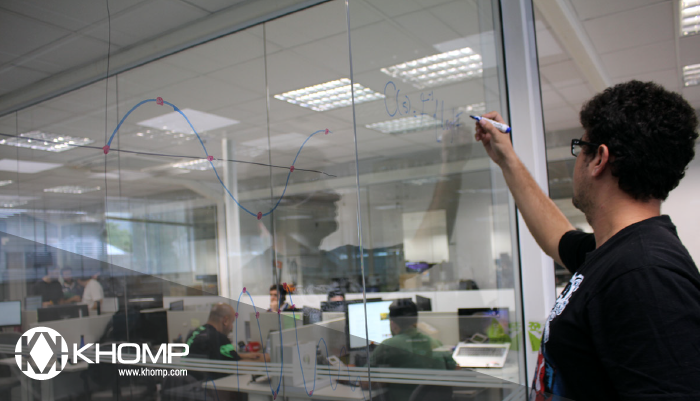Khomp uses design thinking as a methodology for becoming increasingly innovative and competitive. As a methodology, this process is encouraged in all areas of the company, thus facilitating the interaction between them and, consequently, the steps of the methodology. Therefore, the stages of the process are distributed in the company’s attitudes, from the design of its physical structure, to the support given to each customer, after-sales.
Inside the 6 Steps of Design Thinking within the Khomp Software Development Process
Design thinking is a methodology created to solve everything from day-to-day situations to complex projects, and is developed in 6 steps. To know more about each of the steps, read another post here: Design Thinking in software development.
At Khomp, empathy is present in every event undertaken, meeting held, in each support team service action and in every training provided to our clients and collaborators. One of the elements in the company’s mission precisely addresses efficiency in the relationship with the client. To achieve this goal, it is necessary to exercise empathy in each meeting, and to understand the needs and desires of each client.
The definition of the point of view is the result of two important aspects: the constant monitoring of the telecommunications market and its various aspects, to form business introspection, and communication with each client. With these two elements, it is possible to form an extensive record of the difficulties of each consumer, and the possible opportunities for development.
The idealization stage of a solution, which can often be a service or product, is made up of brainstorming sessions in various areas at Khomp, including coordinators, development leaders, CTOs, collaborators in related fields and other stakeholders. The sessions serve not only for the creation of new ideas, but also for evolution and for choosing those that will be integrated into the prototype. Here it is important to note that, in addition to horizontal management, with very few levels of hierarchy in the sectors, Khomp’s internal physical structure is basically composed of glass: large rooms with few partitions facilitate communication between people and closed rooms have glass walls, optimizing the flow of information also between departments. The meeting rooms where the brainstorming sessions take place are also all glass. The glass facilitates idealization through collaborative drawings and sketches on the walls, adding value to the results from the session.
During the development of a new product, various refinements will be made at the time of construction of the first prototype. The rectifications performed act as the intermediate cycle between prototyping and testing, with internal revisions between the hardware and software development teams. After this initial validation, tests are initiated by a specialized group. The Testing Department performs simulations of the prototype operating in a real scenario, with a higher processing load and higher levels of demand than the previous stage. This step starts a new cycle of internal revisions in the prototype, between the hardware and software development teams and now also the Testing Department. The result of this second cycle is the project – Beta version.
The last test step is already performed in real scenarios, which is called the Field Test. The package to be tested is not restricted to the product or service in its Beta version, but also the documentation of release notes, with emphasis on the description of the characteristics and the idea built during the steps of definition and idealization, as well as the final technical documentation (datasheet, manuals, etc). This phase is highly valued. It is where Khomp receives customer and market feedback for continuous product improvement and subsequent commercial launch.
The Khomp case presented here is one of the methodologies used in the day-to-day work of its collaborators. Learn more about the Design Thinking methodology in this other post.

